Top News
October 27, 2020 Ryukyu Shimpo
Okinawa Prefecture continues to see new cases of COVID-19 on the rise, recording the largest number of new cases per 100,000 people since October 3, the worst for all prefectures in Japan. If the spread of the virus continues at its current pace, there is a fear that Okinawa will reach its fourth and highest warning level “Widespread Infection,” leading Okinawa Governor Denny Tamaki to put out a new “Okinawa Coronavirus Warning” unique to the prefecture. The prefectural government is urging residents to raise their awareness and change their behaviour, noting that the risk of infection has increased, “Due in large part to gatherings for food and alcohol (particularly large group).”
Of the seven indicators used to determine the warning level, as of October 26 three of the indicators: “Hospital bed occupancy rate” (74.2%), “Cases requiring medical treatment” (356 people), and “New cases from the past week” (242 people) have all reached level four.
Previously the prefecture has issued advisories targeting specific areas identified as hot zones four times previously, but this has not led to a decrease in the number of cases.
Since there continue to be new clusters of the disease arising, the prefecture decided to issue a “warning” for individuals and business to thoroughly enact COVID-19 prevention measures.
In the warning, the prefectural government is asking to limit groups going out to no more than five people, to finish within two hours, and to refrain from heavy drinking or bar hopping. Governor Tamaki stressed, “To commit to treating this as necessary as opposed to merely keeping it in mind.”
(English translaiton by T&CT and Sam Grieb)
Go to Japanese
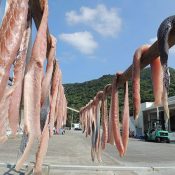
October 27, 2020 Ryukyu Shimpo
By Takahito Arashiro
Kunigami Village’s autumnal tradition of sun-drying funuiyu (Okinawan for mahi-mahi) began in Ginama. The Funuiyu Festival is held annually around this time of the year at the Ginama fishing port, but this year it was canceled due to the novel coronavirus pandemic. Nevertheless, the fishermen began fishing this month, using a 300-year method passed down in the region.
On October 15, Ginama Mayor Mitsuo Urasaki gathered local fishers and residents to the port to kick off the full-scale fishing operations and to dismantle and carve the catch. At around 6 a.m., five fishing boats departed one after another from the Ginama fishing port before dawn. The fishermen caught 30 kg of funuiyu near the floating fish reef and returned to port about two hours later. The fishermen and locals carved the funuiyu into fillets, pickled them in salt for an hour, and hung them in a breezy spot under the sun.
This year, Ginama’s shared store plans to sell 700-gram fillets for 2,000 yen each, beginning early November while monitoring the catch volume. They are inviting everyone to visit and taste the treasured sun-dried funuiyu only available during the fall season.
(English translation by T&CT and Monica Shingaki)
Go to Japanese
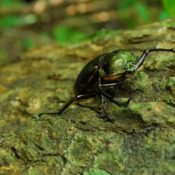
October 21, 2020 Ryukyu Shimpo
Northern Okinawa – On October 13, the Joint Council to Prevent Poaching of Yambaru Long-Armed Scarab Beetles (an office of the Okinawa Amami Nature Conservation Office of the Ministry of the Environment) conducted a joint patrol with the villages of Kunigami, Higashi, and Ogimi to prevent poaching. On this day, they patrolled forest roads in the area and did not encounter any poaching activity.
The Yambaru long-armed scarab beetle is Japan’s largest beetle and exists only in the northern part of Okinawa Island. The beetle was discovered in 1983 and declared a natural monument of Japan, a rare domestic species of flora and fauna (the Law for the Conservation of Endangered Species), and endangered according to the IUCN Red List of Threatened Species. Male beetles may have front legs of up to 9 centimeters.
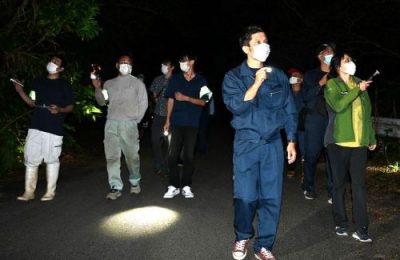
Affiliated individuals who patrol the forest roads. (October 13, Kunigami)
The Joint Council to Prevent Poaching of Yambaru Long-Armed Scarab Beetles was established in 2001. It includes the Ministry of the Environment, forest agencies and other national institutions, the prefectural government, prefectural police, four villages in Northern Okinawa including Kunigami, and the University of the Ryukyus. Originally, the group aimed to protect the Yambaru long-armed scarab beetle, but its protection has expanded to include a species of stag beetle (Neolucanus okinawanus) as well as birds and animals.
The joint patrol on October 13 was joined by approximately thirty people from affiliated organizations. The group split up to patrol 4 routes.
Before setting out, the head of the Ministry of the Environment Yambaru Natural Conservation Office explained poaching. The rare species that are poached in Okinawa and Amami have been found in a variety of places from hotels to post offices and pet shops. It has also been confirmed that rare species from the Nansei Islands are bought and sold online internationally.
Aina Yokoyama, from the Natural Conservation Office, explains, “Showing that we are working to increase awareness of the illegality of the collection itself, and that we are working on countermeasures, will discourage poaching.” She adds, “Even if they are alive, we cannot return creatures to their natural habitats after they have been taken by poachers (due to disease concerns). It’s vital that we prevent poaching in the creatures’ habitats.”
In northern Okinawa, the Ministry of the Environment conducts around two hundred routine patrols annually. The prefectural government also conducts close to two hundred patrols in a year. The Ministry of the Environment patrols forest roads while the prefecture patrols within the forest.
(English translation by T&CT and Ellen Huntley)
Go to Japanese
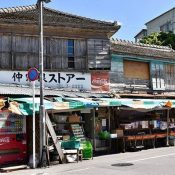
October 23, 2020 Ryukyu Shimpo
By Takahiro Kina
Motobu – The Nakasone Store, which has been operating for over 50 years in the Toguchi neighborhood of Motobu near the Motobu Town Market, will be undergoing a rebuild due to deterioration. The shop familiar to many with a history in the area will be moving to a temporary location, after which the original building will be torn down. Second-generation owner Junko Nakasone said, “It will be sad to see it go, but we want to create a safe environment for the third-generation ownership.”
Junko, the store’s poster girl, took over the store eight years ago from her mother, Yoshiko, and she had passed away. Starting with the achicoco tofu delivered each morning at 4:30 a.m. the store offered a wide variety of items such as bento boxes and side dishes, and snacks for children returning home from school, and was beloved in the neighborhood. The store owners had considered a rebuild many times before due to things such as roof leaks, but it was after the store’s symbolic bougainvilleas were destroyed in a typhoon two years ago that finally led them to decide on a rebuild last year.
Junko, who will pass the baton on to the third-generation owner, her second son Koji, 34, commented, “We have been kept in business by the support of everyone in the community. We will never forget our gratitude and will keep doing our best.”
The store is open from 5:30 a.m. – 8:00 p.m. (7:00 a.m. – 6:00 p.m. Sundays). Inquiries can be made to the Nakasone Store at (Tel.) 0980 (47) 2023.
(English translation by T&CT and Sam Grieb)
Go to Japanese
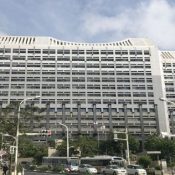
October 22, 2020 Ryukyu Shimpo
Regarding the issue of carcinogenic chemicals including perfluorooctane sulfonate (PFOS) being detected in water from a group of wells on a U.S. military base in Kadena, which are sources of water for Chatan Water Treatment Plant, on October 20 Mayor Masaharu Noguni of Chatan Town paid a visit to Director Norimi Tanahara of the Prefectural Enterprise Bureau and submitted a letter requesting that the safety of tap water be maintained. In the letter Mayor Noguni requested that the plant stop taking in water from this group of wells, that other sources of water be secured, and that appropriate measures be taken to remove contaminants.
The request was released to the press corps prior to the visit. Mayor Noguni, in an interview after voicing his objection, said that Director Tanahara had put emphasis on the fact that the total value of PFOS and PFOA per 1 liter of water will decrease year by year and had explained that the amount of water being brought in from these sources is being reduced. In response to an inquiry regarding stopping the use of water from these sources, Director Tanahara said, “Given that we must also make provisions against water shortage and the like, it will be difficult”.
Mayor Noguni stated: “Given that there are differences in water depending on the region, we cannot grasp [the effects]. Although the value [of PFOS/PFOA per liter] is decreasing, the apprehension cannot be completely erased. I hope for continuous improvements”.
(English translation by T&CT and Erin Jones)
Go to Japanese
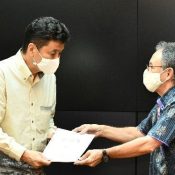
October 23, 2020 Ryukyu Shimpo
On October 22, during his visit to Okinawa, Defense Minister Nobuo Kishi met with Governor Denny Tamaki; Lt. Gen. H. Stacy Clardy III, commander of the U.S. troops in Okinawa and Okinawa Area Coordinator; and mayors of the municipalities hosting U.S. military bases in Okinawa. The governor and the defense minister discussed the plan to relocate U.S. Marine Corps Air Station Futenma to Henoko, Nago City, and the Naha Port Facility; however, they failed to reach an agreement. Governor Tamaki noted public opinion and urged to halt the new military base construction. On the other hand, Minister Kishi insisted that “relocation to Henoko is the only viable solution.”
Tamaki stressed, “The prefecture’s proposal should be considered seriously and [the government] should take swift action to eliminate the dangers posed [to residents] by Futenma Air Base.” In response, Kishi explained the importance of maintaining deterrence capabilities.
Governor Tamaki requested the formation of SACWO, a framework for three-party discussions. However, the defense minister responded, “Since the Japanese government negotiates with the United States, it is not considering SACWO at this time.”
Tamaki also referenced the idle Naha Port and requested it to be returned, independent from the Urasoe City relocation plan. Minister Kishi disagreed by stating, “The agreement was that the facilities would be returned after building an alternative facility in Urasoe City and moving its functions there. Fulfilling those agreements is the fastest path to its return.”
(English translation by T&CT and Monica Shingaki)
Go to Japanese
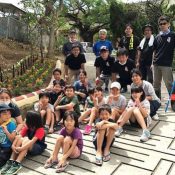
October 20, 2020 Ryukyu Shimpo
By Hiroe Nakagawa
Flower beds made with the red roofing tiles called aka kawara from Shuri Castle, which was destroyed in a fire, have started blooming flowers such as marigold and bougainvillea in various colors, delighting the eyes of both children and passerby.
The flower beds were designed by the “Tsuboya Dads’ Association” (Yasutomo Nerome, chairman), a group that watches out for the safety of the children of Tsuboya. They offer the children a reminder about the castle while raising the flowers, and the group hopes that being surrounded by flowers will bring smiles to their faces.
The flower beds were built in September by children, parents, teachers, and other members of the community. They were constructed with support from representative director Atsushi Tabata and Genki Horikiri from the Ryukyu Aka Kawara and Mortar Construction Association. The beds run along the path from the school entrance to the school building, about 10 meters long on the left side, and 14 meters long on the right. Around 300 flowers have been planted in the beds.
Dads’ Association chairman Nerome said, “Because of the flower beds, the children will remember both Shuri Castle and the experience of raising flowers.”
(English translation by T&CT and Sam Grieb)
Go to Japanese
October 20, 2020 Ryukyu Shimpo
Recently, University of Tokyo Atmosphere and Ocean Research Institute associate professor Chuya Shinzato, Okinawa Institute of Science and Technology Graduate University (OIST) professor Noriyuki Sato, and others decoded the genome of 18 species of coral in the Acroporidae family, including 15 species of coral in the Acropora genus living in the sea around Ishigaki Island and Okinawa Island. As a result, they learned that species of coral in the Acropora genus may have survived a warmer marine environment by forming clouds to block out sunlight. The research team expects the genome information obtained through their research to serve as an important tool for understanding whether the corals will be able to adapt to climate change going forward.
A paper compiling the research results was published in the English language science journal Molecular Biology and Evolution put out on October 15.
The research team analyzed the genome information of the 18 Acropora corals together with fossil records. They also revealed that the ancestors of Acropora emerged in the Cretaceous period, when there was no ice in the North and South Poles and dinosaurs lived in a climate warmer than our climate today.
Corals have DMSP lyases, enzymes that break down DMSP molecules to generate a compound called dimethyl sulfide (DMS). When DMS is released from the ocean into the atmosphere it collects water vapor and turns to water droplets and ice, and is thought to assist the generation of clouds.
This research revealed that Acropora coral has at most around 20 genes for producing DMSP lyases, which is more than other types of coral. The research team believes, based on this result, that Acropora ancestors may have survived warm environments in the past by the formation of clouds.
Associate Professor Shinzato, who is from Okinawa, said, “It is presumed that there is some mechanism for forming clouds from DMS, but there is no evidence yet. I hope to continue this research with the team going forward.”
(English translation by T&CT and Sandi Aritza)
Go to Japanese
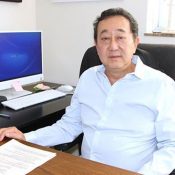
October 18, 2020 Ryukyu Shimpo
By Akihide Celso Shiroma
São Paulo, Brazil—On July 20, law nº 17,395 went into effect, adding World Uchinanchu Day to the city’s Official Calendar of Events. The text of the measure states: “With the purpose of carrying on the legacy of Brazil’s Okinawan pioneer immigrants through debate and preservation of Okinawan traditions and values, October 30 shall be designated World Uchinanchu Day.”
The bill, submitted in 2019, was authored by São Paulo City Councilman Aurélio Nomura. Nomura said, “Like the Okinawa Festival, adding World Uchinanchu Day [to the São Paulo Official Calendar of Events] is a significant symbol of gratitude and respect for the Okinawan contribution to our immigrant population and development of São Paulo.”
According to Claudia Sayoko Iha, a Naha-City nisei and aide to Councilman Nomura, the bill passed unanimously. The council also heard from members of the Okinawan community.
At Nikkei community events, there are spaces where politicians and delegates from each club can mingle. It was there that Councilman Nomura learned of the World Uchinanchu Festival and later visited Okinawa. Nomura shared that he had a “great” meeting with Okinawa’s governor and mayors during his trip.
The councilman and his family have had a long-standing relationship with Okinawan-Brazillian families of the community. While working for his grandfather at Kaigai Kogyo Kabushiki Kaisha (KKKK), Nomura determined the property boundaries in Registro, located in the backlands of São Paulo; his right-hand man at the time was Okinawan. Furthermore, Nomura’s father introduced the San Vicente mayor to a Naha City politician when serving as a congressman.
Councilman Nomura said, “By instituting World Uchinanchu Day, I hope that São Paulo residents will take interest and add to our relationship with Okinawa, including tourism development.”
(English translation by T&CT and Monica Shingaki)
Go to Japanese
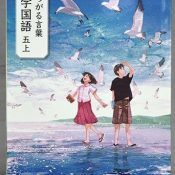
October 16, 2020 Ryukyu Shimpo
Newspaper Week began on October 15. A Ryukyu Shimpo article, “Yanbaru Kuina Hocho Kunigami Kotsu Jiko de Chiryo Kaifuku” (Okinawa Rail Released in Kunigami, Treated and Recovered After Traffic Accident, July 5, 2017, Local News) is used in Hirogaru Kotoba Shogaku Kokugo Go-Jou, a Japanese Language textbook for fifth grade released by Kyoiku Shuppan (Tokyo) and used throughout Japan since spring. The textbook is being used in elementary schools throughout the country, including multiple schools in Okinawa. Articles from four national newspapers are featured in the textbook, but Ryukyu Shimpo is the only local paper to appear.
The article is used in the lesson “Let’s Make an Information Notebook,” which introduces ways to collect and organize information. The article describes the release of an Okinawa rail (yanbaru kuina) that was hit by a vehicle on a prefectural road in Kunigami and then protected. The article also presents calls by the NPO Dobutsutachi-no-byoin-Okinawa (Animal Hospital Okinawa) for everyone to be more careful when driving, which were prompted by large numbers of accidents involving Okinawa rails.
The article is presented in the textbook as though it was cut out of the newspaper. Pupils are instructed to underline new things they learned or parts they had questions about. They are also told to make note of their source when they compile information in their Information Notebook. A representative of Kyoiku Shuppan explains the reason they chose the article. “It’s a story with a lot of depth. It will lead students to notice environmental problems and other social issues and to form their own opinions of how to solve problems. Because of this, we thought it was an appropriate article to include in the textbook.”
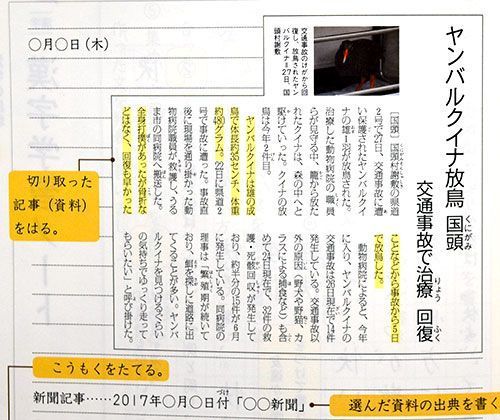
The Ryukyu Shimpo Article “Yanbaru Kuina Hocho Kunigami” as it appears in the textbook Hirogaru Kotoba Shogaku Kokugo Go-Jou.
(English translation by T&CT and Ellen Huntley)
Go to Japanese
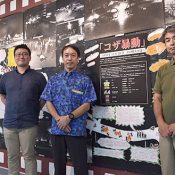
October 16, 2020 Ryukyu Shimpo
December 20, 2020, will mark 50 years to the day since a riot broke out in Okinawa City (former Koza City) following a U.S. serviceman striking an Okinawan in a car accident; in what became to be known as the Koza Riots, protesters set fire to U.S. military vehicles. On October 13, Histreet—an Okinawa City gallery for postwar culture and history, opened its special exhibit titled, Reflecting on the ‘Koza Riots’ 50 Years Later. The exhibit shines light on the aftermath of the riots which broke out half a century ago in Koza City, and the impact it had on the local residents. The exhibit will run until January 31, 2021.
Histreet has mounted three special exhibits since 2010, but the current exhibit will be the first to focus on social conditions and local sentiments following the Koza Riots. The exhibit portrays Koza City on December 20, 1970, using large maps indicating where vehicles were set ablaze and locations where locals clashed with military police. Through photographs and firsthand accounts given by residents and police officers, the exhibit paints a vivid picture of the incident.
The exhibit offers context to then-High Commissioner James B. Lampert’s statements relating to the delay in transporting poisonous gasses; it also underlines the ambivalence that was felt towards the series of off-limits orders issued by the U.S. military, which lead to a stagnation in local economic activities.
Yoichi Hiroyama, a historian for the city, pointed out: “Different people had different takes on the Koza Riots and military presence in Okinawa.” He added, “I hope that this exhibit of historical records presenting the situation and social conditions of the day, will encourage each and every visitor to think about the Koza Riots and how it shaped Okinawa.”
Admission is free. Hours of operation are Tuesday through Sunday, 10 a.m. to 6 p.m. For inquires, call 098-929-2922.
(English translation by T&CT and Monica Shingaki)
Go to Japanese











 Webcam(Kokusai Street)
Webcam(Kokusai Street)


